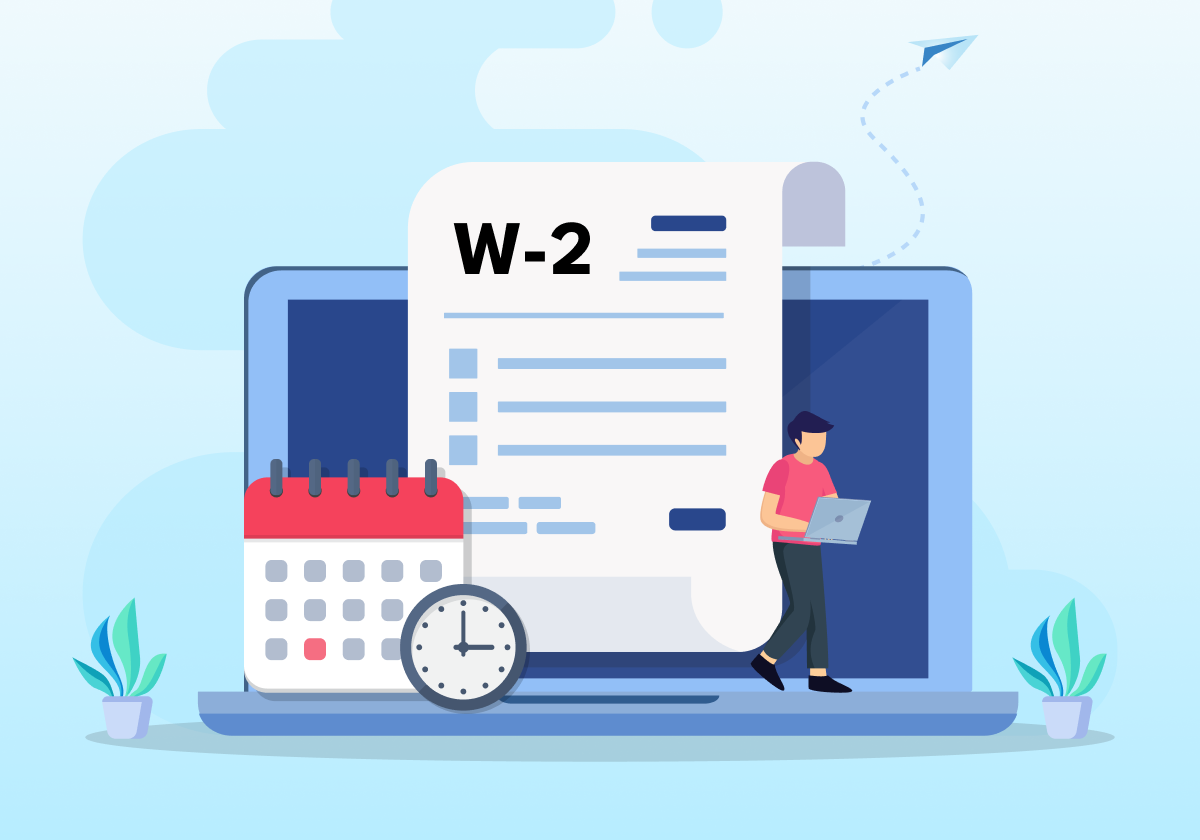Attention, Employers! Understanding the W2 Deadline of 2023 is crucial for a smooth tax season. This blog simplifies the process, explaining when to send W2 forms to your employees and when to report them to the IRS. Let’s make tax filing stress-free!
Understanding The Form W-2 and Its Significance
The Form W-2, often called the Wage and Tax Statement, plays a pivotal role in the world of taxes. It’s not just a piece of paper; it’s a critical document for employers and employees.
Why the W-2 Matters:
The W-2 is the backbone of tax reporting. For employers, it’s not just recommended; it’s a legal requirement. Employers must provide W-2 forms to their employees, which must also be reported to the IRS. Failing to do so accurately and on time can lead to penalties.
For Employees:
On the flip side, the W-2 is what individuals rely on to file their taxes accurately. It contains a detailed breakdown of their income, including wages, tips, bonuses, and taxes withheld throughout the year.
Beyond Taxes:
W-2s aren’t just about taxes; they are proof of income for various financial transactions. Inconsistencies or errors on the W-2 can lead to misreported taxes, audits, and financial troubles for employers and employees.
Understanding the significance of the W-2 sets the stage for navigating the upcoming deadlines, ensuring that everyone meets their obligations and maintains tax compliance.
Deadline for Employers to Send Out W2 Forms
As the tax season approaches, employers are responsible for sending out W2 forms to their employees.
The W2 Distribution Deadline
Employers are required by law to provide W2 forms to their employees by a specific deadline. This deadline typically falls on January 31st of each year. However, if the 31st falls on a weekend or holiday, the deadline is usually extended to the next business day. For example, if January 31st falls on a Saturday, the new deadline would be February 1st.
Deadline for W2 Reporting to the IRS
As employers fulfill their obligation of sending out W2 forms to employees, another important aspect of tax compliance awaits their attention – reporting these forms to the Internal Revenue Service (IRS) and to state governments under certain conditions.
The IRS Reporting Deadline
Reporting W2 forms to the IRS coincides with the deadline for distributing them to employees – typically January 31st of each year. This alignment simplifies the process, allowing employers to simultaneously provide employee copies and the IRS with the necessary information. However, similar to the distribution deadline, if January 31st falls on a weekend or holiday, the reporting deadline extends to the next business day.
The State Reporting Deadline
Each state has it’s own requirements for W2 filing. You can look up the specific requirements on the Tax1099 website to see what your obligations are.
Penalties for Missing W2 Deadlines
While adhering to W2 deadlines is crucial, failing to meet them can have financial implications for employers. The Internal Revenue Service (IRS) imposes penalties for missing out on these deadlines. Let’s delve into the potential penalties employers may face:
- Late Filing Penalty: If an employer fails to file W2 forms with the IRS by the deadline, they may incur a late filing penalty. The severity of this penalty depends on how late the filing is. For small businesses (with average annual gross receipts of $5 million or less), the penalty is $60 per W2 if filed within 30 days of the due date. If filed more than 30 days late but by August 1st, the penalty increases to $120 per W2. If filed after August 1st or not filed at all, the penalty is $310 per W2.
- Intentional Disregard: If the IRS determines that an employer intentionally disregarded the W2 filing requirement, the penalty can be much higher. In such cases, the penalty can reach up to $630 per W2, with no maximum limit.
- Inaccurate Information: If the W2 forms submitted to the IRS contain inaccurate information and the employer does not correct the errors, they may face a penalty of $310 per W2.
- Failure to Provide Employee Copies: Employers must also provide employee copies of W2 forms by the deadline. Failure to do so can result in penalties of $60 per W2, with a reduced maximum penalty for small businesses but no maximum if it is determined that the failure was due to intentional disregard of their obligation.
It’s important to note that these penalties can add up quickly, especially for larger organizations or those with significant employees. Therefore, it is in the best interest of employers to ensure timely and accurate filing of W2 forms to avoid these financial repercussions.
In addition to financial penalties, missing W2 deadlines can lead to employee dissatisfaction, tax filing errors, and potential audits. Therefore, employers should take their responsibilities seriously and meet established deadlines to maintain compliance and smooth tax operations.
Tips for Meeting W2 Deadlines
Meeting W2 deadlines is not just a regulatory requirement; it’s a practice that ensures a smooth and hassle-free tax season for both employers and employees. Here are some valuable tips to help employers meet W2 deadlines effectively:
- Plan Ahead: The key to meeting W2 deadlines is preparation. Start the process well in advance, ideally at the beginning of the year, to allow ample time for gathering, verifying, and distributing W2 forms.
- Double-check Employee Information: Ensure that all employee information is accurate and current. This includes names, addresses, Social Security numbers, and tax withholding information. Accurate employee details are crucial for error-free W2 forms.
- Use Payroll Software: Consider using payroll software or outsourcing payroll services. These tools can streamline the W2 preparation process, reducing the chances of errors and delays.
- Stay Informed: Keep yourself informed about any updates or changes in tax laws and regulations. The IRS may introduce new requirements or forms; staying current is essential for compliance.
- Set Reminders: Create a timeline with clear deadlines for each W2 preparation and distribution process step. Set reminders to ensure that each task is completed on time.
- Train Staff: If multiple employees are involved in the W2 preparation process, ensure they are well-trained and understand the importance of meeting deadlines. Coordination and communication among staff members are essential.
- Utilize Electronic Options: Consider electronic delivery of W2 forms to employees, which can be faster and more efficient than traditional paper forms. Many employees prefer electronic delivery, and it can save on printing and postage costs.
- Perform Internal Audits: Conduct internal audits to verify the accuracy of W2 forms before distribution. This proactive approach can help identify and rectify errors before they become problematic.
- Have a Backup Plan: Prepare for unforeseen circumstances like technical issues or last-minute changes. A contingency plan can help you meet deadlines even in challenging situations.
- Seek Professional Help: If you’re unsure about any aspect of W2 preparation or have a large workforce, consider consulting with tax professionals or hiring a tax service provider to ensure compliance.
Meeting W2 deadlines is not just about avoiding penalties; it’s about fostering a sense of responsibility, professionalism, and trust among employees. By following these tips and making a concerted effort to meet deadlines, employers can navigate the tax season smoothly while maintaining the confidence of their workforce.
eFile Form W-2 With Tax1099: An IRS-Approved eFiling Solution Provider
Filing W2 forms manually can be a time-consuming and error-prone, especially for businesses with many employees. To simplify and streamline the process while ensuring compliance with IRS regulations, consider using Tax1099, an IRS-approved eFiling solution provider.
Tax1099 offers a comprehensive eFiling platform that caters to the needs of employers, making the W2 filing process efficient and hassle-free. Here’s why Tax1099 is a trusted choice for employers:
- Bulk W2 Filing: If your business has numerous employees, manually preparing and filing individual W2 forms can be overwhelming. Tax1099 simplifies this by allowing bulk W2 filing, allowing you to upload all your W2 data simultaneously. This feature is a time-saver for businesses of all sizes.
- Data Import: Tax1099 provides an easy-to-use data import feature, allowing you to import employee data directly from your payroll or accounting software. This minimizes the risk of data entry errors and ensures accurate employee information.
- API Integration: For businesses with complex systems or a large volume of forms to file, Tax1099 offers API integration options. This allows seamless data transfer and filing directly from your existing systems.
- Electronic Delivery to Recipients: Tax1099 facilitates the electronic delivery of W2 forms to your employees in addition to filing with the IRS. This not only speeds up the distribution process but is also eco-friendly.
- Secure Data Handling: Tax1099 prioritizes data security. Your sensitive employee information is handled carefully and protected through secure encryption protocols.
- Customer Support: Should you encounter any issues or have questions during the filing process, Tax1099 offers customer support to assist you immediately.
Accurate and timely tax reporting is crucial for both employers and employees. Using a reliable eFiling solution like Tax1099 can save you valuable time and resources while reducing the risk of errors. By taking advantage of features like bulk filing, data import, and electronic delivery, you can simplify the entire W-2 filing process, ensuring a seamless experience for your business and employees. Trust Tax1099 to be your partner in efficient and compliant tax reporting.



